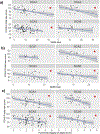The Cerebellar Cognitive Affective/Schmahmann Syndrome Scale in Spinocerebellar Ataxias
- PMID: 38165578
- PMCID: PMC11217149
- DOI: 10.1007/s12311-023-01651-0
The Cerebellar Cognitive Affective/Schmahmann Syndrome Scale in Spinocerebellar Ataxias
Abstract
The Cerebellar Cognitive Affective/Schmahmann Syndrome (CCAS) manifests as impaired executive control, linguistic processing, visual spatial function, and affect regulation. The CCAS has been described in the spinocerebellar ataxias (SCAs), but its prevalence is unknown. We analyzed results of the CCAS/Schmahmann Scale (CCAS-S), developed to detect and quantify CCAS, in two natural history studies of 309 individuals Symptomatic for SCA1, SCA2, SCA3, SCA6, SCA7, or SCA8, 26 individuals Pre-symptomatic for SCA1 or SCA3, and 37 Controls. We compared total raw scores, domain scores, and total fail scores between Symptomatic, Pre-symptomatic, and Control cohorts, and between SCA types. We calculated scale sensitivity and selectivity based on CCAS category designation among Symptomatic individuals and Controls, and correlated CCAS-S performance against age and education, and in Symptomatic patients, against genetic repeat length, onset age, disease duration, motor ataxia, depression, and fatigue. Definite CCAS was identified in 46% of the Symptomatic group. False positive rate among Controls was 5.4%. Symptomatic individuals had poorer global CCAS-S performance than Controls, accounting for age and education. The domains of semantic fluency, phonemic fluency, and category switching that tap executive function and linguistic processing consistently separated Symptomatic individuals from Controls. CCAS-S scores correlated most closely with motor ataxia. Controls were similar to Pre-symptomatic individuals whose nearness to symptom onset was unknown. The use of the CCAS-S identifies a high CCAS prevalence in a large cohort of SCA patients, underscoring the utility of the scale and the notion that the CCAS is the third cornerstone of clinical ataxiology.
Keywords: Cerebellar cognitive affective syndrome; Cognition; Scale; Spinocerebellar ataxia.
© 2023. The Author(s), under exclusive licence to Springer Science+Business Media, LLC, part of Springer Nature.
Conflict of interest statement
C.U.O. receives research support from Alector Inc. and Transposon Inc., and consults for Acadia Pharmaceuticals. He is also supported by the Robert and Nancy Hall for Brain Research, and the Joseph Trovato Fund.
L.S.R. is site PI for Biohaven Pharma and has consulted for Bial Biotech and Reata Pharmaceuticals. She receives research support from NINDS, Pfizer, the National Ataxia Foundation, Gordon and Marilyn Macklin Foundation, and the Daniel B and Florence E. Green Foundation.
M.D.G is site PI for Biohaven Pharma, receives funding from the NIH/NIA (R01 AG AG031189; R01AG062562; R56 AG055619) and is supported by the Michael J. Homer Family Fund.
J.D.S. is site PI for Biohaven Pharma, consults for Biohaven, and holds the copyright with the General Hospital Corporation to the Brief Ataxia Rating scale, Patient Reported outcome Measure of Ataxia, the Cerebellar Cognitive Affective / Schmahmann Syndrome Scale, and the Cerebellar Neuropsychiatric Rating Scale.
Figures




References
MeSH terms
Grants and funding
LinkOut - more resources
Full Text Sources
Research Materials
Miscellaneous

